For many dog lovers, the joy of pet ownership is often overshadowed by frustrating allergies. Sneezing, itching, and wheezing can turn cuddle time into a challenge. This is where the concept of “hypoallergenic” dogs, or more accurately, dog breeds that don’t shed much, becomes incredibly appealing. While no dog is entirely allergen-free, certain breeds produce fewer allergens due to their low-shedding coats, making them a better fit for individuals with sensitivities. Understanding which breeds fall into this category can open up a world of companionship for allergy sufferers. [cite:dog breeds list with pictures and price]
Dogs are among the most beloved pets, but allergic reactions can complicate interactions. The key to managing allergies often lies in minimizing exposure to dander—the microscopic flakes of skin that dogs shed, along with their hair. Low-shedding breeds release significantly less dander into the environment, potentially reducing allergic symptoms. This guide will explore what makes a dog a suitable choice for allergy sufferers and provide a comprehensive list of dog breeds that don’t shed, offering insights into their temperaments and care requirements.
Understanding Dogs That Don’t Shed
The term “hypoallergenic dog” can be misleading, as all dogs produce allergens. However, low-shedding dogs are specifically recognized for producing fewer allergens in their hair and dander. These breeds tend to shed less, which means less dander is released into your home environment. It’s crucial to remember that even dogs that don’t produce much dander still carry allergens in their skin, saliva, and urine, all of which can trigger allergic responses like coughing, itching, or wheezing in sensitive individuals. Therefore, while these breeds are a better option for those with allergies, they are not a guaranteed solution for everyone.
Managing allergies requires a multi-faceted approach, even with a low-shedding dog. Regular grooming, diligent house cleaning, and consulting with healthcare professionals are all vital steps to ensure a comfortable coexistence. The goal is to reduce the overall allergen load in your home, allowing you to enjoy the company of a canine companion with fewer adverse reactions.
List of Dog Breeds That Don’t Shed
While there is no such thing as a completely allergen-free dog, many breeds are better suited for people with allergies because they shed minimally. Here’s a comprehensive list of some of the best dog breeds that don’t shed:
1. Poodle
Poodles are renowned for their hypoallergenic qualities and come in three distinct sizes: Standard, Miniature, and Toy. These highly intelligent dogs shed very little and are known for their distinct curly coats. The Standard Poodle was originally bred for hunting, while the Miniature and Toy Poodles were developed as smaller companions. Regardless of size, Poodles require consistent grooming to prevent their dense curls from tangling and matting. Their playful and intelligent nature makes them excellent family pets.
 White Poodle walking through green grass
White Poodle walking through green grass
2. Yorkshire Terrier
These small, spirited dogs are a popular choice among allergy sufferers. Yorkies boast silky, fine hair that is more similar to human hair than typical dog fur, contributing to their low-shedding nature. They possess spunky and affectionate personalities and adapt well to various living situations, from spacious homes to studio apartments, as long as they receive ample attention and love from their families. Their compact size and charming demeanor make them delightful companions. [cite:smart small dogs that are easy to train]
3. Shih Tzu
The Shih Tzu is another small, low-shedding breed with a long history as a companion dog. They are recognized for their luxurious thick coats and exceptionally friendly temperaments, making them wonderful lapdogs. However, their distinctive flat faces can predispose them to certain health concerns, including overheating, breathing difficulties, and tear stains. Regular eye cleaning can help manage tear stains, and vigilant care is needed to keep them comfortable, especially in warm weather.
 Brown and white Shih Tzu lying on a living room floor
Brown and white Shih Tzu lying on a living room floor
4. Miniature Schnauzer
One of three Schnauzer breeds, the Miniature Schnauzer is the smallest, typically standing no more than 14 inches tall and weighing between 10–20 pounds. These smart and alert dogs fit seamlessly into various living environments. They have a wiry double coat that sheds minimally, but requires regular stripping or clipping to maintain its condition. Miniature Schnauzers are energetic and require at least an hour of daily exercise to stay happy and healthy.
5. Standard Schnauzer
The Standard Schnauzer shares many of the desirable traits of its miniature counterpart but in a larger frame, weighing up to 45 pounds. These dogs are intelligent, protective, and energetic, making them excellent companions for active families. Their wiry coats are low-shedding but need routine grooming. Standard Schnauzers thrive on activities such as long walks, games of fetch, and engaging with puzzle toys, which provide both physical and mental stimulation.
6. Giant Schnauzer
As their name suggests, Giant Schnauzers are among the largest low-shedding breeds, capable of reaching over 27 inches in height and weighing up to 85 pounds. These powerful and intelligent dogs require substantial exercise to maintain their well-being. Activities like extended walks, running, hiking, and vigorous games of fetch are essential to keep them mentally stimulated and physically content. Their dense, wiry coats require consistent grooming to prevent matting.
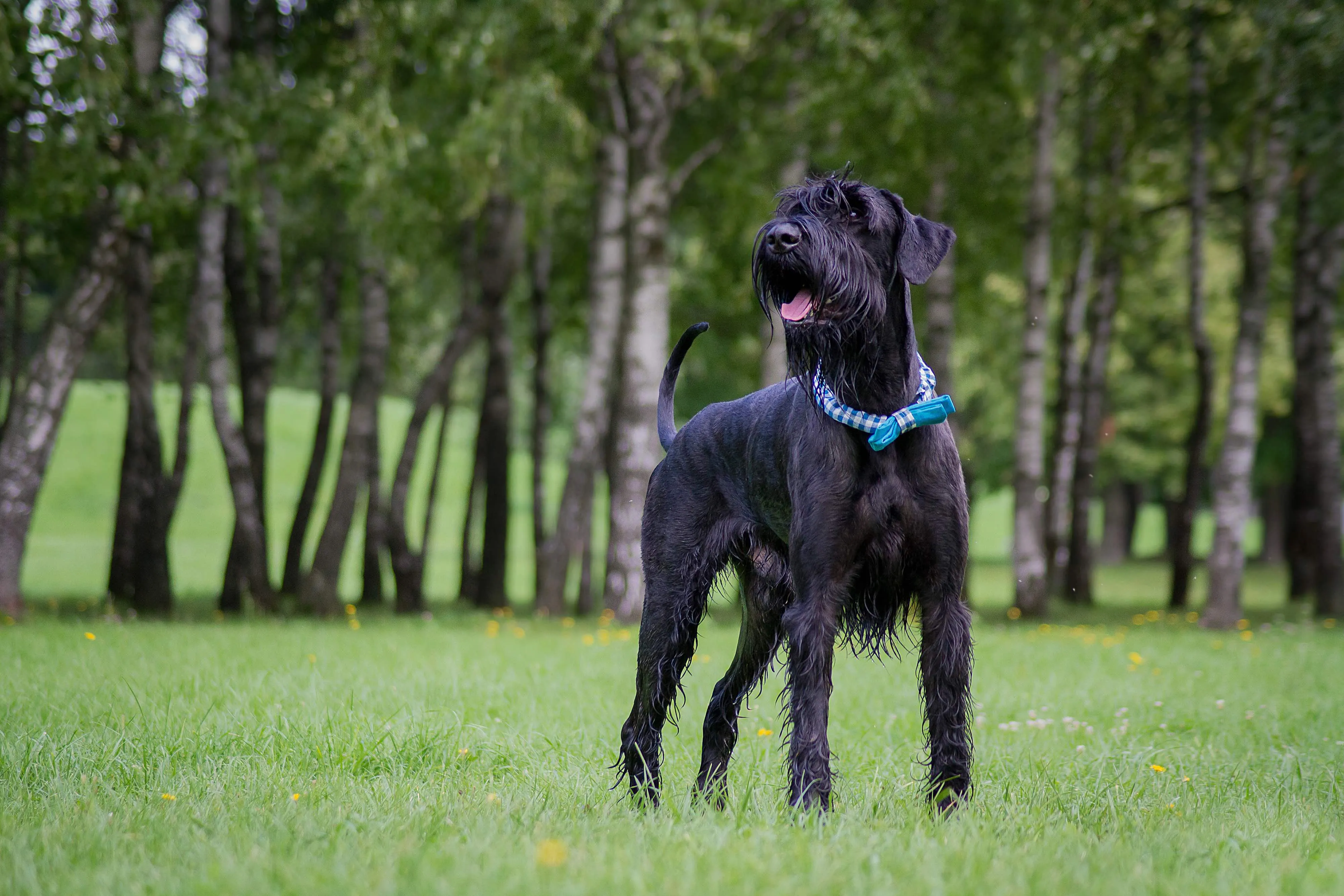 Black wet Giant Schnauzer wearing a blue bow collar standing in a park
Black wet Giant Schnauzer wearing a blue bow collar standing in a park
7. Bichon Frise
The Bichon Frise is a small, playful, and affectionate pup with a distinct curly, low-shedding coat. These intelligent and highly trainable dogs quickly master basic commands with positive reinforcement and can even learn impressive tricks. Their cheerful disposition and compact size make them adaptable to many living situations, bringing joy and companionship to their families. Regular grooming is necessary to keep their fluffy white coats in top condition.
8. Chinese Crested
Known for their unique appearance, the Chinese Crested comes in two varieties: hairless and powderpuff. The hairless variety has smooth, soft skin with tufts of hair on their head, tail, and paws, while the powderpuff is covered in a long, silky coat. Both varieties are considered low-shedding. These dogs are playful, affectionate, and make wonderful, devoted companions, despite their unusual looks.
9. Portuguese Water Dog
This medium-sized breed was historically used to assist fishermen in Portugal. Portuguese Water Dogs are a popular low-shedding choice due to their thick, curly coats that shed minimally. They are intelligent, highly trainable, and friendly, possessing a high-energy level that necessitates regular exercise. Activities like swimming, which they adore, are excellent for keeping these pups happy and healthy.
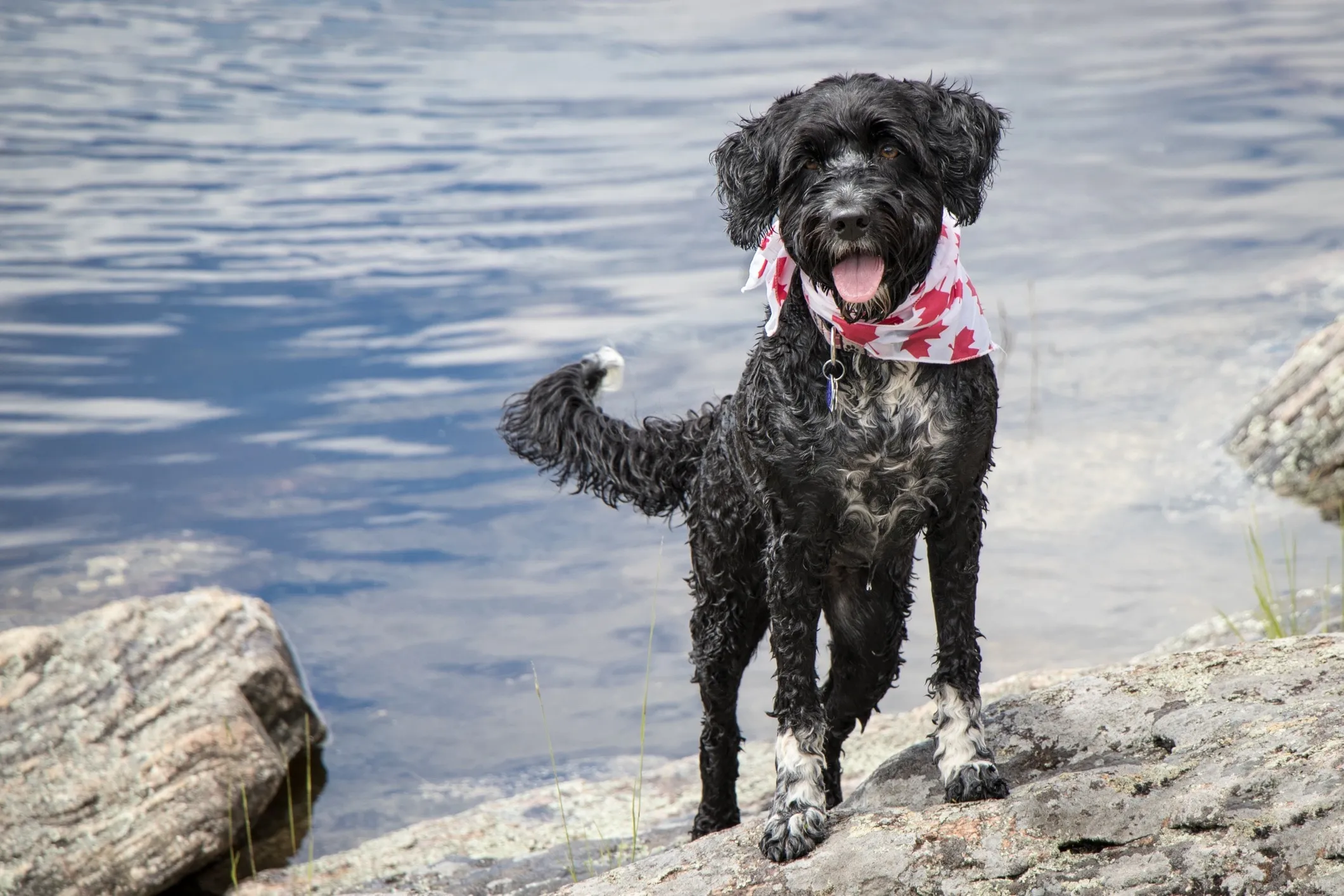 Black and white Portuguese Water Dog wearing a red maple leaf bandana in front of water
Black and white Portuguese Water Dog wearing a red maple leaf bandana in front of water
10. Labradoodle
A crossbreed between a Labrador Retriever and a Poodle, the Labradoodle was originally developed as a low-allergen service dog. They are intelligent, friendly, and make excellent family pets. Labradoodles are highly trainable and gentle, particularly when they receive consistent exercise and are socialized from a young age. Their coats vary but are generally low-shedding, inheriting this trait from their Poodle parent.
11. Goldendoodle
Another popular “doodle” breed, Goldendoodles are a cross between a Golden Retriever and a Poodle. Like Labradoodles, they are low-shedding, possess a friendly nature, and are highly intelligent. While often recognized for their golden coats, they can exhibit a wide range of colors and textures. Goldendoodles require frequent grooming with a slicker brush to prevent matting and keep their coats healthy.
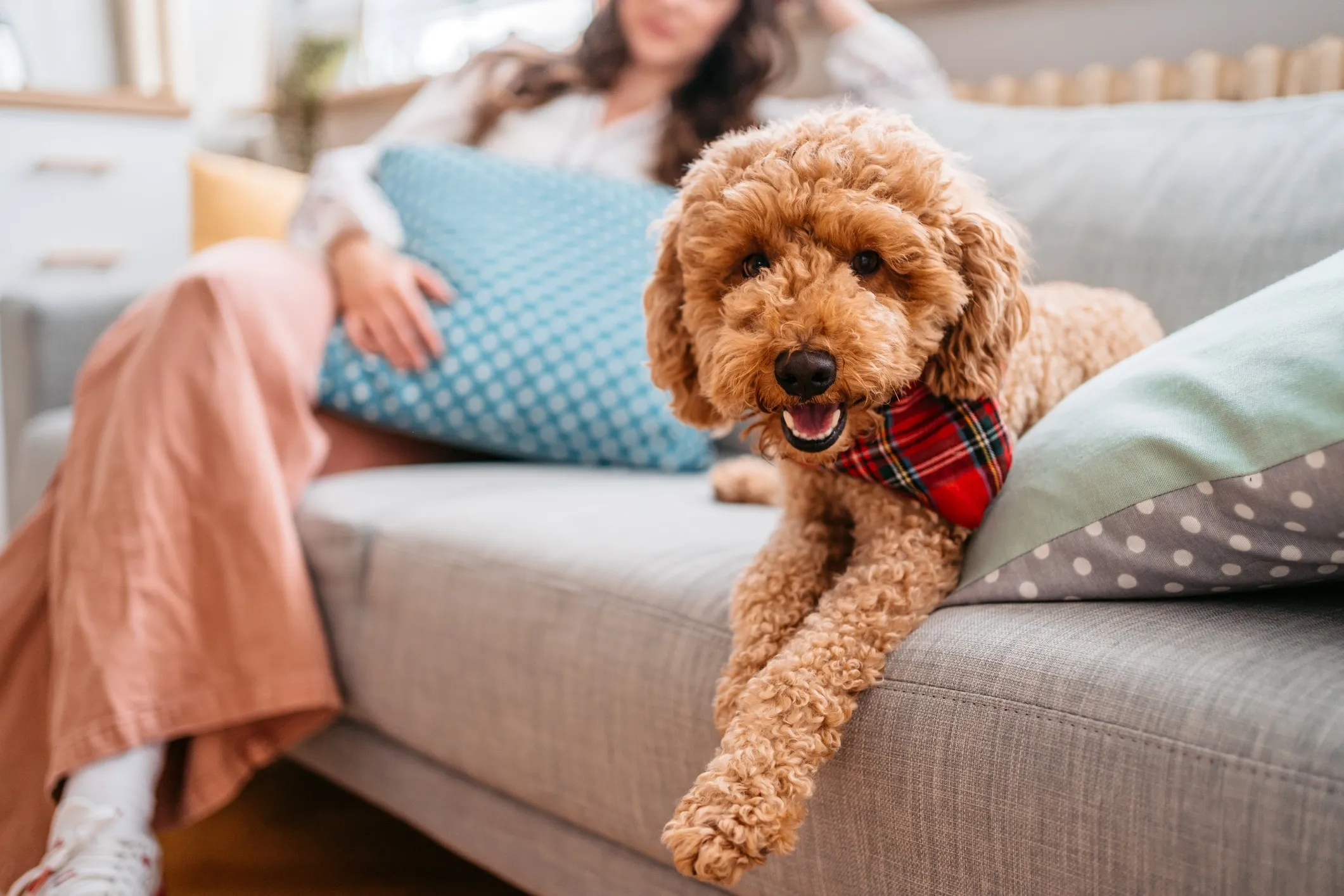 Goldendoodle lying on a couch with a person sitting in the background
Goldendoodle lying on a couch with a person sitting in the background
12. Lagotto Romagnolo
Originally bred as water retrievers, Lagotto Romagnolo dogs have distinctive curly, woolly coats that protected them from cold waters. While less common, these dogs can be excellent family pets, known for being good with children and other pets. Their unique coats are low-shedding but require specific grooming to prevent matting and maintain their texture.
13. Affenpinscher
Affenpinschers are small, charming dogs known for their monkey-like expressions. Their dense, wiry coats produce fewer allergens compared to many other breeds. However, their coats demand significant care, including regular at-home brushing and a process called “stripping,” where hair is removed from the root rather than trimmed.
14. Irish Water Spaniel
Friendly, intelligent, and highly trainable, Irish Water Spaniels are another water dog breed originally used for retrieving game. Their thick, curly coats require regular grooming and are always a distinctive liver (brown) color. These high-energy dogs need plenty of exercise to stay happy and healthy, making them ideal for active individuals or families.
15. Aussiedoodle
An Aussiedoodle is a cross between an Australian Shepherd and a Standard or Miniature Poodle. These low-shedding dogs are exceptionally smart and energetic, inheriting traits from both parent breeds. To prevent destructive behaviors, Aussiedoodles require significant exercise and mental stimulation through enrichment toys and training.
16. Bolognese
Originating in Italy, Bolognese dogs are cute, playful, and easygoing. They feature a long, fluffy white coat that, despite its characteristic messy appearance, needs diligent grooming. These pups are known for getting along well with children and other pets, making them adaptable to various living situations and wonderful companions.
17. Maltese
Another small, low-shedding dog, the Maltese is famous for its luxurious, flowing white coat. Maltese make affectionate and playful companions, but prospective owners must be prepared for their significant grooming needs, especially if maintaining a long coat. Many owners opt for a shorter “puppy cut” to simplify daily care.
18. Soft Coated Wheaten Terrier
This medium-sized Irish breed is named for its incredibly soft, silky coat that sheds minimally. Wheatens maintain a high energy level throughout their lives and require ample exercise and mental stimulation to be well-behaved and content. Their playful and devoted nature makes them joyful additions to active households.
19. Coton de Tulear
A small, low-shedding breed from Madagascar, Cotons de Tulear are known for their easygoing and good-natured personalities. Their agreeable temperament makes them suitable companions for other pets and children, particularly when proper introductions are made. Their soft, cotton-like coats need regular grooming to prevent matting. [cite:small dog breeds with pictures and price]
20. Schnoodle
Unlike many “doodle” breeds that mix a Poodle with a shedding dog, the Schnoodle combines two low-shedding breeds: the Schnauzer and the Poodle. Their coats can be curly or wavy, depending on genetic inheritance, but are consistently low-shedding. Schnoodles are intelligent, playful, and often described as having a zest for life, making them delightful family members.
21. Bedlington Terrier
Often described as “a lamb in dog’s clothing,” the Bedlington Terrier is a small, curly-haired breed recognized by its distinctive topknot and pom-pom ear tufts. These affectionate dogs thrive on human companionship and can develop separation anxiety if left alone for extended periods. Their unique woolly coat sheds very little but requires specialized grooming to maintain its distinctive appearance.
22. Xoloitzcuintli (Mexican Hairless Dog)
One of the oldest and rarest dog breeds, the Xoloitzcuintli (pronounced “sho-lo-eets-kweent-lee”) comes in three sizes (toy, miniature, and standard) and two coat varieties: hairless and coated. Both are considered low-shedding. The hairless variety has smooth skin, making them an excellent choice for allergy sufferers. They are intelligent, calm, and devoted to their families.
23. Whoodle
A cross between a Soft-Coated Wheaten Terrier and a Poodle, the Whoodle is a friendly, intelligent dog that sheds very little. They inherit their affectionate nature and sharp minds from both parent breeds, making them highly trainable and wonderful companions. Whoodles require regular exercise and mental engagement to prevent boredom.
24. Bernedoodle
Bernedoodles are a crossbreed of Bernese Mountain Dogs and Poodles. These large, low-shedding dogs are celebrated for their friendly, affectionate, and gentle demeanor, making them a popular choice for families with children and other pets. They require plenty of exercise to stay active and happy, benefiting from their Poodle parent’s low-shedding coat.
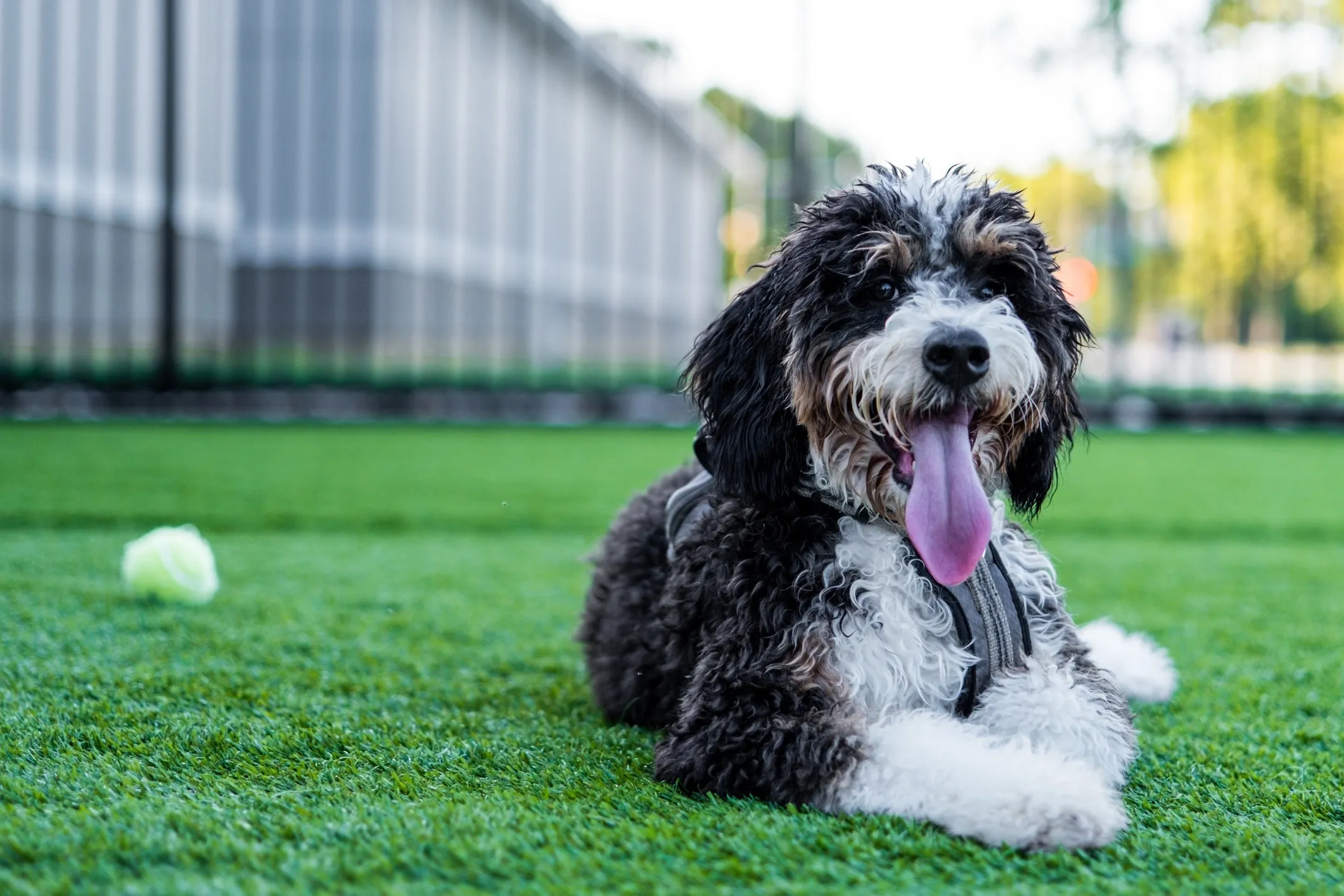 Large Bernedoodle dog lying in grass with his tongue out
Large Bernedoodle dog lying in grass with his tongue out
25. Shorkie
The Shorkie is a mixed breed resulting from the crossing of a Shih Tzu and a Yorkshire Terrier—two breeds already known for their low-shedding qualities. These small, playful, and friendly dogs combine the best traits of both breeds. Like most dogs on this list, they require a dedicated and regular grooming routine to maintain their coats. [cite:cute dogs breed and price in india]
26. Afghan Hound
Afghan Hounds are striking dogs known for their long, flowing coats and slender builds. While their coats are substantial, they are single-layered and shed less frequently than many other breeds. These elegant pups are built for speed, being among the fastest dog breeds. They are loving toward their families but can be aloof with strangers, so early and consistent socialization is crucial.
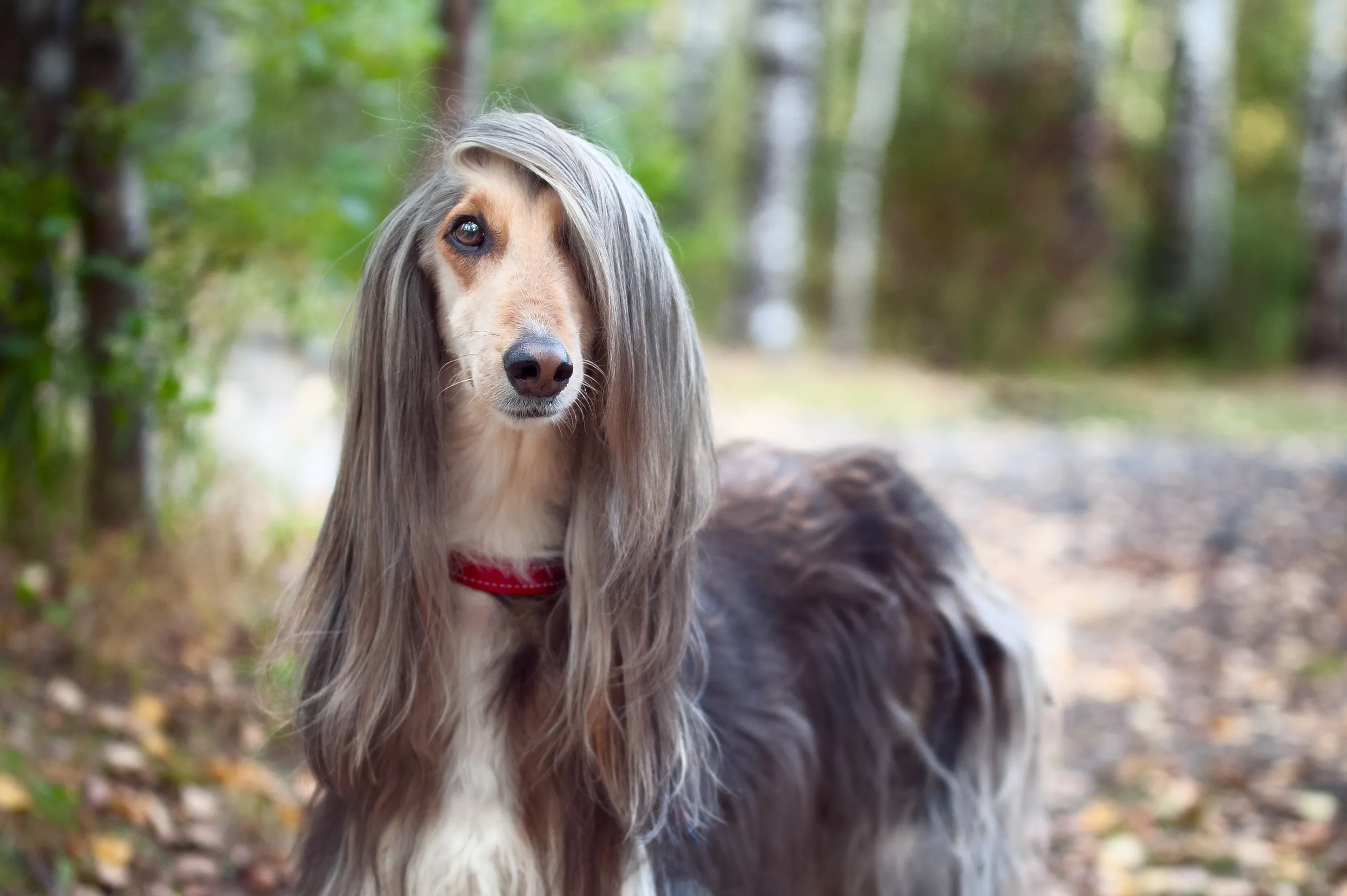 Gray and tan Afghan Hound looking at the camera
Gray and tan Afghan Hound looking at the camera
27. Barbet
The Barbet, pronounced “bar-bay,” is a cheerful dog with a shaggy, woolly coat, aptly named from the French word “barbe” (beard). This large, low-shedding dog loves to swim, thanks to its protective curly coat. To maintain their coat’s condition, especially after water activities, regular brushing with a slicker or pin brush two to three times a week is essential.
28. Shih-Poo
The Shih-Poo is a mixed breed, typically a cross between a Shih Tzu and a Toy Poodle. This small pup thrives in almost any living situation, provided they receive about 30 minutes of exercise and a good brushing session daily. They are known for their affectionate nature and generally low-shedding coats.
29. Peruvian Inca Orchid
Peruvian Inca Orchids are rare, ancient dogs that are low-shedding due to their nearly hairless bodies. They come in three sizes (small, medium, and large) and are the national dog of Peru. These elegant dogs are intelligent, lively, and devoted to their owners, though they can be reserved with strangers.
30. Malshi
A cross between the Maltese and Shih Tzu, the Malshi is a happy, small, low-shedding dog. They thrive on close companionship with their favorite humans and are known for their playful and affectionate personalities. Like their parent breeds, Malshis require regular grooming to keep their soft coats in good condition.
Tips for Living With a Low-Shedding Dog
Bringing home a low-shedding dog is a significant step toward managing pet allergies, but it’s not the only factor. Pet parents need to be proactive in several areas to ensure a clean, allergen-minimized environment and a healthy, happy dog.
Keep Up With Grooming
Even low-shedding dogs require regular care and maintenance to minimize allergens. Consistent grooming and bathing are essential for keeping their coats clean and reducing the amount of dander in your home. Ideally, dogs should be brushed weekly, and bathed every four to six weeks. Using specialized shampoos designed to reduce pet dander can be particularly beneficial for allergy sufferers. Many low-shedding breeds also need regular trimming, hand-stripping, or other professional grooming upkeep, so factor this into your budget or learn how to groom your pup at home.
Maintain a Clean House
Minimizing allergens extends beyond dog grooming to your home environment. Regular vacuuming, dusting, and washing of bedding are crucial steps to reduce pet dander accumulation. Using air purifiers can help filter allergens from the air, and ensuring good ventilation in your home will also contribute to a lower allergen load. Focus on areas where your dog spends the most time, such as carpets, furniture, and their sleeping areas.
Talk to Your Doctor
Managing your allergies and preventing allergic reactions is paramount when living with any dog, including low-shedding breeds. The most effective way to manage allergies is to consult with your healthcare provider. They can offer guidance on various treatment options, which may include medication, nasal sprays, or allergy injections. It’s also important to be mindful of avoiding direct contact with your dog’s saliva or urine, as these bodily fluids can also trigger allergic responses in sensitive individuals.
Embracing a low-shedding dog can profoundly enhance the quality of life for individuals with allergies. These breeds allow those sensitive to pet dander to experience the immeasurable joy and companionship of having a dog, without the constant burden of severe allergic reactions.
By Nicole Zittritsch, LVT, BSc, MPH
